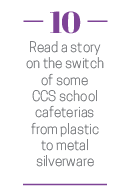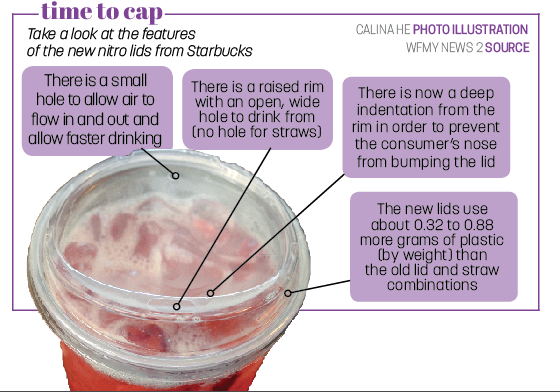
I am the proud owner of metal straws—six of them to be exact. My family keeps the set in our car, and whenever we go somewhere we try to use it instead of plastic alternatives. In case we forget to bring them, we simply don’t use a straw and drink straight from the container. It’s really not that bad.
Now, I’m not saying you should order your own set of metal straws off of Amazon immediately. Instead, I simply encourage you to incorporate habits more mindfully into your life that consume less plastic, thus keeping landfills and oceans cleaner.
Using reusable straws—as well as reusable shopping bags and water bottles—only takes a couple seconds of planning and is much better for the environment than regularly using their plastic counterparts. According to The Telegraph, plastic straws take around 200 years to decompose in landfills, and the United Nations Educational, Scientific and Cultural Organization states 100,000 marine animals and one million seabirds die from plastic entanglement every year.
Due to this, I applaud Starbucks’ recent efforts to combat the issue by incorporating nitro lids into their stores. In most restaurants, the waiters are trained to give the guests plastic straws with drinks, so whether or not they are used, they are often thrown away when the table is cleared. However, Starbucks is making strawless the norm, as customers have to request to receive straws, forcing them to reconsider if a straw is really necessary.
I hope other restaurants learn from this and change their training protocol so waiters only provide disposable straws upon request. Customers can help with this initiative; for example, if you go to a restaurant without a request-only policy, I encourage you to tell your waiter you don’t want a straw before they set it on the table.
But while small steps like these can make a difference, I still wonder if there is a better solution. Why, for example, are metal straws not counted as a standard part of cutlery such as a metal spoon or fork? To be fair, manufacturing one metal straw uses up about 100 times more energy than a plastic one, but because each of these straws can last much longer, especially if reused for years, this endeavor makes the most sense from an energy standpoint. More importantly, this will greatly reduce the amount of plastic waste released.
These changes have an impact. According to The New York Times, Americans use between 170 to 390 million single-use plastic straws every day. According to BBC, Starbucks’ straw ban alone will cut down on an estimated 1 billion straws a year, or 2.7 million straws every day. Especially when coupled with similar initiatives from major companies like Disney, McDonald’s, Hyatt and some airline companies, among others, these changes will not only reduce the blind usage of plastic straws but also open up the conservation on reducing our consumption of plastic as a whole.
So, the next time you go to a restaurant and order a soda, think of Starbucks and skip the straw or bring your own. You would not only be eliminating one more straw from going to the landfills or ocean but might even encourage other people to do the same.
The views in this column do not necessarily reflect the views of the HiLite staff. Reach Rhea Acharya at [email protected].




























![Keep the New Gloves: Fighter Safety Is Non-Negotiable [opinion]](https://hilite.org/wp-content/uploads/2024/12/ufcglovescolumncover-1200x471.png)
















































![Review: “We Live in Time” leaves you wanting more [MUSE]](https://hilite.org/wp-content/uploads/2024/12/IMG_6358.jpg)
![Review: The premise of "Culinary Class Wars" is refreshingly unique and deserving of more attention [MUSE]](https://hilite.org/wp-content/uploads/2024/12/MUSE-class-wars-cover-2.png)
![Introducing: "The Muses Who Stole Christmas," a collection of reviews for you to follow through winter [MUSE]](https://hilite.org/wp-content/uploads/2024/12/winter-muse-4.gif)
![Review: "Meet Me Next Christmas" is a cheesy and predictable watch, but it was worth every minute [MUSE]](https://hilite.org/wp-content/uploads/2024/11/AAAAQVfRG2gwEuLhXTGm3856HuX2MTNs31Ok7fGgIVCoZbyeugVs1F4DZs-DgP0XadTDrnXHlbQo4DerjRXand9H1JKPM06cENmLl2RsINud2DMqIHzpXFS2n4zOkL3dr5m5i0nIVb3Cu3ataT_W2zGeDAJNd_E-1200x884.jpg)
![Review: "Gilmore Girls", the perfect fall show [MUSE]](https://hilite.org/wp-content/uploads/2024/11/gilmore-girls.png)
![Review in Print: Maripaz Villar brings a delightfully unique style to the world of WEBTOON [MUSE]](https://hilite.org/wp-content/uploads/2023/12/maripazcover-1200x960.jpg)
![Review: “The Sword of Kaigen” is a masterpiece [MUSE]](https://hilite.org/wp-content/uploads/2023/11/Screenshot-2023-11-26-201051.png)
![Review: Gateron Oil Kings, great linear switches, okay price [MUSE]](https://hilite.org/wp-content/uploads/2023/11/Screenshot-2023-11-26-200553.png)
![Review: “A Haunting in Venice” is a significant improvement from other Agatha Christie adaptations [MUSE]](https://hilite.org/wp-content/uploads/2023/11/e7ee2938a6d422669771bce6d8088521.jpg)
![Review: A Thanksgiving story from elementary school, still just as interesting [MUSE]](https://hilite.org/wp-content/uploads/2023/11/Screenshot-2023-11-26-195514-987x1200.png)
![Review: "When I Fly Towards You", cute, uplifting youth drama [MUSE]](https://hilite.org/wp-content/uploads/2023/09/When-I-Fly-Towards-You-Chinese-drama.png)
![Postcards from Muse: Hawaii Travel Diary [MUSE]](https://hilite.org/wp-content/uploads/2023/09/My-project-1-1200x1200.jpg)
![Review: "Ladybug & Cat Noir: The Movie," departure from original show [MUSE]](https://hilite.org/wp-content/uploads/2023/09/Ladybug__Cat_Noir_-_The_Movie_poster.jpg)
![Review in Print: "Hidden Love" is the cute, uplifting drama everyone needs [MUSE]](https://hilite.org/wp-content/uploads/2023/09/hiddenlovecover-e1693597208225-1030x1200.png)
![Review in Print: "Heartstopper" is the heartwarming queer romance we all need [MUSE]](https://hilite.org/wp-content/uploads/2023/08/museheartstoppercover-1200x654.png)



